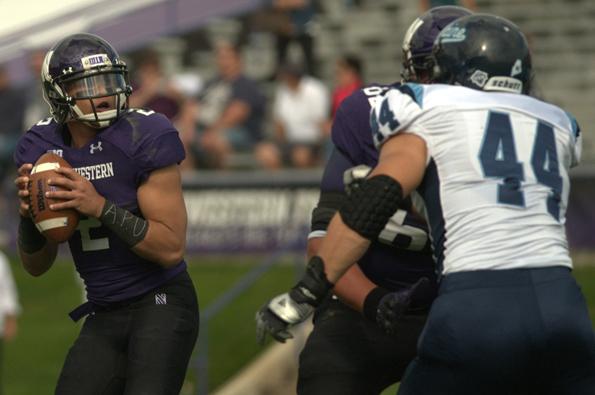Northwestern union’s legacy of reform lives on

Former Northwestern quarterback Kain Colter spearheaded the movement for unionization of Wildcat football players. Despite his best efforts, the National Labor Relations Board unanimously rejected the NU petition in August.
September 22, 2015
Up to Date
Catch up on the biggest ongoing news stories affecting Northwestern and Evanston with The Daily’s new explainer series: Up to Date.
There will be no football-player union at Northwestern, thanks to the National Labor Relations Board’s decision last month not to rule on the historic case.
But although former Wildcats quarterback Kain Colter’s vision for the College Athletes Players Association never came to fruition in Evanston, the dialogue created by his efforts resulted in lasting changes.
“The Northwestern football players have already created change,” CAPA president Ramogi Huma told SI.com in June. “If you look at the amount of pressure they’ve put on the system, a system that’s been refusing to address basic protections for so long, now all of a sudden they have motivation to actually grant some of the things we’ve been fighting for. Just in the last year there have been significant changes in policy.”
When Colter and Huma announced their intent to form a players union in January 2014, they proposed a laundry list of reforms for college athletics, including guaranteed scholarships and stipends to cover the full cost of college attendance. Since then, those ideas have indelibly become part of the college sports conversation and, in some cases, gone from suggestion to reality.
University administrators applauded the focus Colter brought to these issues, although they maintained opposition to the unionization push from the beginning.
“Northwestern considers its students who participate in NCAA Division I sports, including those who receive athletic scholarships, to be students, first and foremost,” University spokesman Al Cubbage said in a statement in August. “We applaud our players for bringing national attention to these important issues, but we believe strongly that unionization and collective bargaining are not the appropriate methods to address the concerns raised by student-athletes.”
Although the union effort failed to accomplish its principle goal — organizing the Cats’ football team — it has left a legacy of reform. Eighteen months after the movement began, college sports have seen a number of changes that follow in its spirit.
Unlimited food for student athletes
The NCAA’s decision in April 2014 to allow student-athletes unlimited meals and snacks appeared to be a direct result of comments by Connecticut basketball star Shabazz Napier, who told media at the NCAA Tournament that, “Sometimes, there’s hungry nights where I’m not able to eat.”
The idea of one of college basketball’s best players going to sleep on an empty stomach because he can’t afford food, then waking up the next day to play in front of thousands of paying fans wearing jerseys with his number struck a chord with enough people to force the NCAA into reform.
Napier’s comments came in direct response to a question about the NU union. In his answer, the NCAA Tournament’s Most Outstanding Player repeated many of Colter’s talking points, touching on the inequity of college athletes generating revenue and being meekly compensated for it.
The interview and subsequent rule change was the most dramatic example of the influence the union movement had simply by forcing conversation about college athletes’ rights.
Major conference autonomy
In forming a union, Colter and Huma dreamed of collectively bargaining players’ rights with the NU athletic department. The only problem: NCAA rules leave very little leeway for additional benefits. For example, one of CAPA’s goals was expanded scholarships that would cover the full cost of college, including rent and food, but NU could not have given the players that if it would have wanted to — NCAA rules don’t allow that kind of benefit because the vast, diverse roster of member schools could not (or maybe would not) accommodate it.
Last August, the NCAA decided to grant additional flexibility to the five major conferences (Big Ten, ACC, Pac-12, Big 12, SEC). The restructuring allowed the conferences to vote on reforms and to act on their own interests without worrying about the smaller athletic departments that might be unable to afford expensive rule changes.
In January, 65 schools in the five major conferences voted on a slate of reforms that resulted in two seismic changes:
1. Players can now receive stipends (between $2,000 and $4,000) to cover the full cost of college.
2. Coaches can no longer pull a student-athlete’s scholarship for athletic performance.
A student-athlete voice in student-athletes’ rights
From the day the union was first announced, Colter emphasized his desire for the players to have a voice in the reform process.
“It’s almost like a dictatorship,” Colter said of the NCAA. “We want someone who is going to be looking out for us.”
Student athletes received that voice in January, when the NCAA announced a new advisory committee comprising 15 athletes from all different sports representing the five major conferences.
One of the athletes selected to represent the Big Ten was NU soccer player Nandi Mehta, a junior and co-captain.
In an interview with The Daily several months later, here’s how Mehta described the newly created Student-Athlete Advisory Committee: “It’s a platform to promote communication between athletes and administrators on campus, or athletes all the way up to the conference or NCAA,” she said. “It’s a place to have the conversation and then implement change.”
Once again, a change that officially had nothing to do with CAPA or Kain Colter had the NU union’s fingerprints all over it. It was not the first time, and it will not likely be the last.
Email: [email protected]
Twitter: @AlexPutterman

